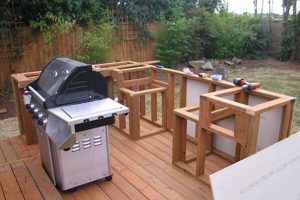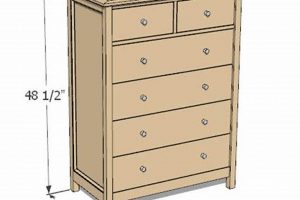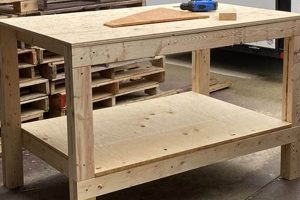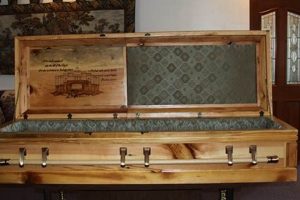Detailed schematics and instructions for constructing a custom workstation to be used in conjunction with a handheld routing tool are readily available. These resources typically encompass a wide array of designs, ranging from simple, benchtop models to more elaborate, free-standing structures complete with integrated dust collection systems and advanced features. The project enables woodworkers to create their own specialized workstation. An example includes instructions detailing the materials and steps required to build a sturdy, accurate platform for shaping wood using a router.
A self-made routing platform offers several advantages. It allows for precise and repeatable cuts, enhancing efficiency and accuracy in woodworking projects. Furthermore, constructing such a platform can be a cost-effective alternative to purchasing a commercially manufactured version. Historically, woodworkers have relied on improvisation and ingenuity to create custom tools and jigs to meet specific needs. This approach aligns with a tradition of resourcefulness and a desire for greater control over the woodworking process.
The subsequent discussion will explore the various aspects of creating such a platform, including design considerations, material selection, construction techniques, and essential safety precautions. This exploration will provide a thorough understanding of the elements involved in successfully fabricating a functional and reliable workstation.
Essential Construction Guidance
The following provides crucial information to maximize the effectiveness and longevity of a shop-fabricated routing platform.
Tip 1: Select High-Quality Materials: The choice of materials directly impacts the stability and durability of the structure. Medium-density fiberboard (MDF) offers a flat, stable surface suitable for the tabletop, while hardwood or plywood is preferable for the frame and legs, ensuring sufficient structural integrity.
Tip 2: Prioritize a Flat and Level Surface: The tabletop’s flatness is critical for accurate routing. Employ a precision level and shims during construction to achieve a perfectly level surface. Periodically check the surface with a straightedge to identify and address any warping or deformation.
Tip 3: Ensure Secure Router Mounting: A robust and stable mounting system is paramount. Use a router plate specifically designed for routing platforms and ensure it is securely attached to the tabletop. Consider incorporating vibration dampening features to minimize movement during operation.
Tip 4: Implement Effective Dust Collection: Routing generates significant amounts of airborne particulate. Integrate a dust collection system, including a dust port directly beneath the router and a shop vacuum, to maintain a clean and safe working environment.
Tip 5: Include a Robust Fence System: The fence is essential for guiding material during routing operations. Construct a fence that is both rigid and adjustable, allowing for precise positioning and secure clamping of the workpiece.
Tip 6: Consider Integrated Safety Features: Incorporate safety measures such as a power switch within easy reach and a clear guard over the router bit. These features enhance user safety and reduce the risk of accidents.
Tip 7: Reinforce High-Stress Areas: Identify areas subjected to high stress, such as the leg attachments and fence mounting points, and reinforce them with additional hardware or bracing. This will prevent premature failure and extend the lifespan of the structure.
Adhering to these suggestions will ensure the construction of a functional, reliable, and safe platform, allowing for precision woodworking operations.
The subsequent section will delve into advanced design modifications and customization options for routing platforms.
1. Design Complexity
The level of intricacy in platform schematics directly influences the capabilities and suitability of the resulting workstation. Simple designs, often involving a basic tabletop attached to a supporting structure, are adequate for fundamental routing tasks. These less complex options are easier and quicker to build. For instance, a basic design might involve attaching a router plate to a pre-existing workbench, offering a cost-effective and space-saving solution. This approach is suitable for hobbyists or those with limited workshop space, but limits functionality.
More complex designs incorporate features such as integrated dust collection systems, adjustable fences, and miter slots. Such features demand greater planning, more specialized materials, and advanced construction techniques. An example of a more intricate design would be a fully enclosed cabinet with built-in drawers for bit storage, a dedicated dust collection port, and an adjustable fence that can be fine-tuned for precision cuts. This design enhances efficiency and improves safety but requires a significant time and resource investment.
The choice of design complexity should align with the anticipated usage and the builder’s skill level. While complex designs offer superior functionality, they also present increased challenges in construction. A thorough assessment of project requirements and available resources is crucial to ensure a successful outcome. Failure to match design complexity with skills may result in a project that is unfinished, unsafe, or does not meet the intended purpose.
2. Material Selection
Material selection is a critical determinant in the success and longevity of a routing platform project. The chosen materials directly influence the structural integrity, accuracy, and overall performance of the finished workstation. Appropriate selection necessitates careful consideration of factors such as stability, durability, cost, and ease of workability.
- Tabletop Surface Composition
The tabletop, serving as the primary work surface, requires a material that exhibits exceptional flatness and stability. Medium-density fiberboard (MDF) is frequently selected due to its consistent density, smooth surface, and resistance to warping. Alternatives include phenolic plywood or solid hardwood. Solid wood, while aesthetically appealing, may be prone to movement with changes in humidity. Considerations must include balancing cost, availability, and the precision demands of intended applications.
- Structural Frame Material
The frame provides the foundational support for the entire routing platform. Strength and rigidity are paramount. Hardwoods such as maple or oak offer superior durability and resistance to deflection under load. Plywood, particularly Baltic birch, presents a cost-effective alternative, providing adequate strength when properly braced and assembled. The choice should account for the overall size and anticipated weight of the projects to be undertaken.
- Fence Construction Materials
The fence guides the workpiece during routing operations and demands precise alignment. Hardwood is often preferred for its stability and machinability. Aluminum extrusion is another viable option, offering exceptional straightness and the ability to integrate adjustable features. The selected material should resist wear from repeated use and maintain its dimensional stability over time. Accuracy will depend on the straightness and precision of the chosen materials.
- Hardware and Fasteners
The hardware used to assemble the platform contributes significantly to its overall structural integrity. High-quality screws, bolts, and inserts are essential for creating secure and lasting connections. Avoid low-grade fasteners that may strip or fail under stress. The selection of appropriate hardware should be based on the type of materials being joined and the anticipated loads. Stainless steel or coated fasteners are recommended for projects exposed to moisture.
The informed selection of materials is integral to the creation of a routing platform that provides accurate, reliable, and safe woodworking operations. A deliberate approach to material procurement, based on a clear understanding of the performance requirements, is vital for project success. A proper understanding of materials is required before attempting any routing platform construction.
3. Accuracy Assurance
In the context of shop-fabricated routing platforms, accuracy assurance constitutes a critical factor influencing the precision and repeatability of woodworking operations. The dimensional precision of components and the stability of the overall structure directly impact the quality of finished projects. Implementing measures to ensure accuracy throughout the design and construction process is essential.
- Tabletop Flatness and Levelness
Achieving a perfectly flat and level tabletop is paramount. Any deviation from flatness introduces inaccuracies in routing depth and consistency. The use of precision measuring tools, such as a straightedge and level, is essential to identify and correct any surface irregularities. MDF, due to its consistent density and stability, is frequently chosen for tabletops. Proper support and bracing beneath the tabletop also contribute to maintaining flatness over time.
- Fence Alignment and Adjustability
The fence serves as a critical guide during routing operations. Its alignment relative to the router bit must be precise and maintained throughout use. A fence system that allows for fine adjustments is essential for achieving accurate cuts and consistent profiles. The fence should be constructed from rigid materials and securely attached to the routing platform to minimize movement or deflection during use. Incorporating a micro-adjuster enhances the ability to make small, precise changes to the fence position.
- Router Plate Stability and Mounting
The router plate provides a stable and level platform for the router itself. The plate must be securely mounted to the tabletop to prevent vibration or movement during operation. The plate should be perfectly flush with the tabletop surface to avoid introducing errors in routing depth. The use of shims or leveling screws may be necessary to achieve perfect alignment. A robust clamping system to secure the router to the plate is also essential for maintaining accuracy.
- Precise Measurement and Marking
Accurate measurement and marking are fundamental to the entire construction process. The use of precision measuring tools, such as a digital caliper and a steel rule, is essential for ensuring accurate dimensions. Careful marking of cutting lines and drilling locations minimizes the potential for errors during assembly. Double-checking all measurements and markings before cutting or drilling is a crucial step in accuracy assurance.
These interconnected facets highlight the importance of meticulous attention to detail and the application of precise techniques when undertaking a shop-fabricated routing platform project. Successfully addressing each of these elements is crucial for creating a workstation that delivers accurate, repeatable, and professional results. Neglecting any one of these aspects can compromise the overall accuracy and effectiveness of the platform, leading to frustration and substandard outcomes.
4. Safety Incorporation
A crucial facet of creating shop-fabricated routing platforms involves the diligent incorporation of safety features. Neglecting this aspect elevates the risk of serious injury, given the inherent dangers associated with high-speed rotating cutting tools. Effective planning and execution of safety measures are not merely optional additions but integral components of any sound construction schematic. The absence of adequate safeguards can lead to severe lacerations, projectile injuries from workpiece kickback, and exposure to harmful dust particles. The design must prioritize operator well-being through a multifaceted approach.
Practical implementation includes integrating a readily accessible power switch to facilitate immediate shutoff in emergency situations. Clear bit guards shield the operator from direct contact with the spinning cutter. Kickback is mitigated through the incorporation of featherboards and hold-downs, which maintain consistent workpiece contact with the fence and table. Furthermore, an effective dust collection system is vital to minimize inhalation of fine particulate matter generated during routing operations. Each element contributes to a safer working environment.
Adherence to established safety protocols and the diligent incorporation of appropriate safeguards within routing platform designs are essential for minimizing risk and fostering a secure workshop environment. Compromising on safety to save time or resources is a false economy, as the potential consequences of an accident far outweigh any perceived benefits. The design and construction process must be grounded in a comprehensive understanding of potential hazards and the application of proven mitigation strategies. Proper safety implementation minimizes danger during use.
5. Dust mitigation
Effective dust mitigation is a critical design consideration for any shop-fabricated routing platform. Routing operations generate substantial amounts of fine particulate matter, posing significant health risks to the operator and contributing to a messy and potentially hazardous work environment. The integration of robust dust collection mechanisms is therefore essential for ensuring a safe and efficient woodworking process.
- Enclosure Design
Enclosing the router within a cabinet or partially enclosed structure can significantly reduce the dispersion of dust. This design strategy contains the majority of particulate matter at the source, facilitating more effective collection through dedicated dust ports. The degree of enclosure should be balanced with accessibility for router adjustments and bit changes. An example includes a cabinet with hinged doors that provide access while minimizing dust escape during operation. The implication is a cleaner and safer work environment.
- Dust Port Integration
The strategic placement and sizing of dust ports are crucial for efficient dust removal. Ports should be positioned as close as possible to the router bit to capture dust before it disperses into the surrounding air. Multiple ports, including one directly beneath the router and another on the fence, can maximize collection effectiveness. An appropriate port size must be selected to maintain adequate airflow without restricting the router’s performance. An underpowered dust collection system with an undersized port will not effectively capture the dust, negating its intended benefit.
- Vacuum System Compatibility
The routing platform design must accommodate connection to a suitable vacuum system. The choice of vacuum system depends on the volume of dust generated and the frequency of routing operations. Shop vacuums are adequate for occasional use, while dedicated dust collectors offer superior performance for heavy-duty applications. Adapters and fittings should be readily available to ensure a secure and airtight connection between the platform and the vacuum system. Incompatible fittings or a poorly sealed connection will result in reduced suction and inefficient dust collection.
- Material Selection for Dust Containment
The materials used in the construction of the routing platform can also contribute to dust mitigation. Smooth, non-porous surfaces, such as melamine or MDF, prevent dust from adhering to the structure, making cleanup easier. Tight joints and sealed seams minimize dust leakage. The use of materials that are resistant to static electricity can also reduce dust buildup. Proper material selection for these reasons can reduce the overall volume of dust in the work environment.
The integration of these design elements into shop-fabricated routing platforms is essential for effective dust mitigation. By prioritizing dust collection, woodworkers can create a safer, healthier, and more efficient work environment. A well-designed dust collection system not only protects the operator’s health but also reduces cleanup time and improves visibility during routing operations. Failure to address dust mitigation effectively can lead to long-term health problems and a compromised work environment.
Frequently Asked Questions Regarding Shop-Fabricated Routing Platforms
The subsequent questions address common inquiries and misconceptions surrounding the design and construction of custom routing platforms, providing clarity on crucial aspects of the project.
Question 1: What are the primary advantages of a shop-fabricated routing platform compared to a commercially manufactured version?
A shop-fabricated platform offers customization tailored to specific needs, potentially lower cost depending on materials, and the satisfaction of creating a tool. Commercially available options may provide superior precision and integrated features but typically at a higher price point.
Question 2: What types of materials are most suitable for the tabletop surface, and why?
Medium-density fiberboard (MDF) is frequently favored due to its flatness, stability, and ease of machining. Hardwood alternatives offer increased durability but are susceptible to dimensional changes with humidity fluctuations.
Question 3: How critical is dust collection, and what constitutes an effective system?
Dust collection is paramount for operator health and workshop cleanliness. An effective system involves a dedicated dust port connected to a high-volume vacuum or dust collector, coupled with an enclosed or partially enclosed router housing to minimize dust dispersion.
Question 4: What safety precautions should be prioritized during the construction and operation of a shop-fabricated routing platform?
Essential precautions include wearing appropriate eye and ear protection, employing featherboards and hold-downs to prevent kickback, ensuring secure router mounting, and implementing a readily accessible power shut-off switch.
Question 5: How important is the precision of the fence system, and what features contribute to its accuracy?
Fence precision is critical for achieving accurate and repeatable cuts. An adjustable fence with micro-adjustment capabilities, constructed from rigid materials, and securely mounted to the platform, is essential.
Question 6: What are the common pitfalls to avoid when designing and building a shop-fabricated routing platform?
Common pitfalls include neglecting dust collection, compromising on material quality to save costs, failing to ensure a perfectly flat tabletop surface, and underestimating the importance of a robust and accurate fence system.
These FAQs offer foundational guidance. Thorough research and careful planning are essential for a successful outcome.
The final section will summarize the key considerations for constructing a effective routing platform.
Conclusion
The preceding exploration of diy router table plans has underscored the multifaceted nature of this endeavor. Key considerations, including design complexity, material selection, accuracy assurance, safety incorporation, and dust mitigation, demand careful attention to detail. A successful project necessitates a comprehensive understanding of woodworking principles, precision in execution, and a commitment to safe operating practices.
The construction of a custom routing platform represents a significant undertaking, offering both opportunities for skill enhancement and the potential for creating a valuable addition to the workshop. By adhering to sound design principles, prioritizing safety, and investing in quality materials, woodworkers can realize a tool that enhances their craft and extends their capabilities. Prudent planning and execution remain paramount for achieving a durable, accurate, and safe diy router table.


![Easy DIY Wire Fish Trap Plans: [Catch More!] The DIY Hub: Creative Crafts, Repairs & Life Hacks Easy DIY Wire Fish Trap Plans: [Catch More!] | The DIY Hub: Creative Crafts, Repairs & Life Hacks](https://craftingdiycenter.com/wp-content/uploads/2025/07/th-1404-300x200.jpg)




